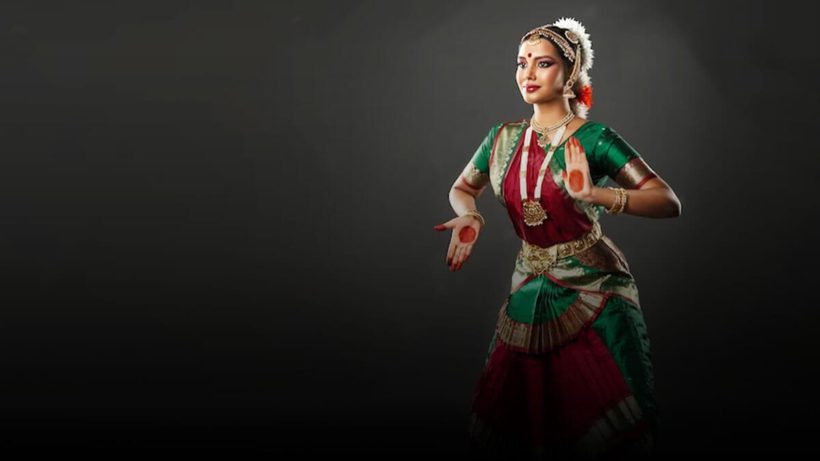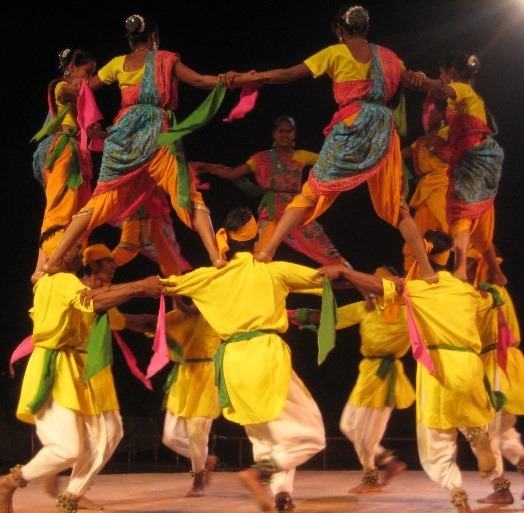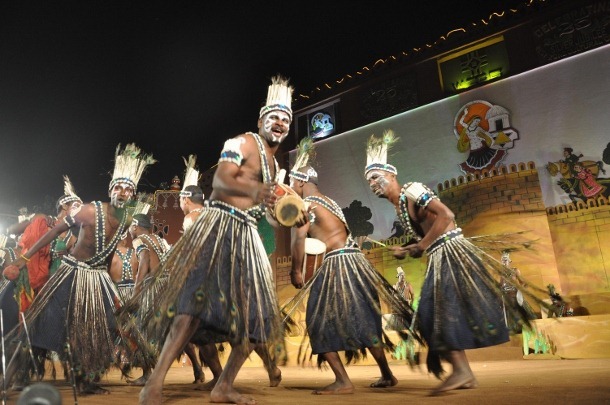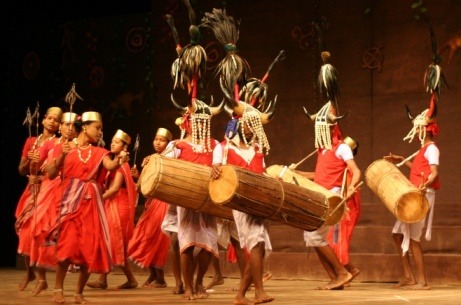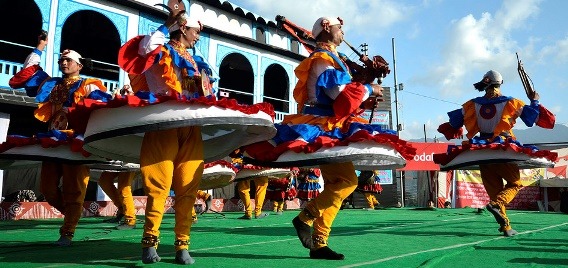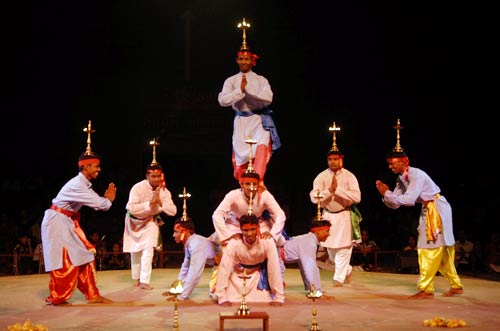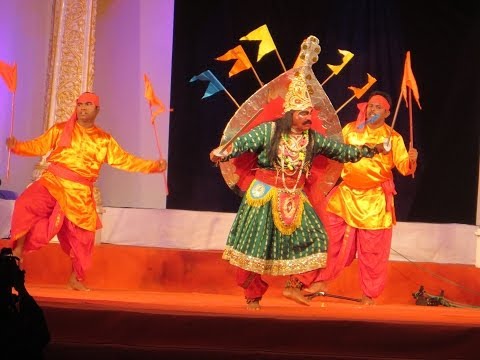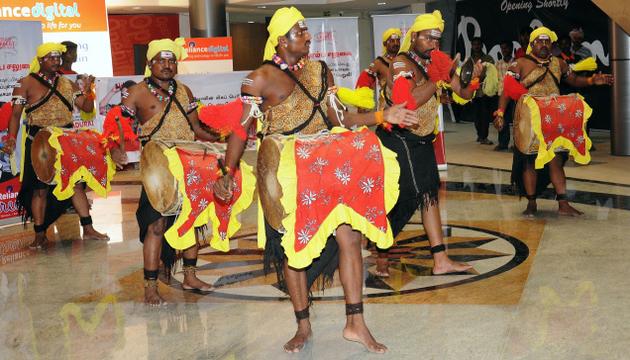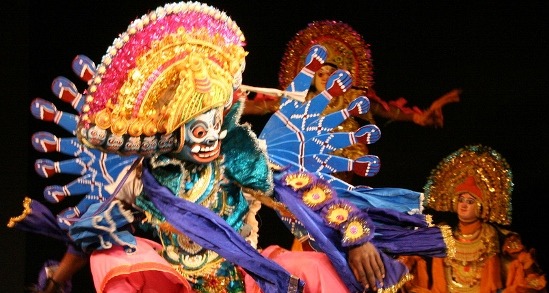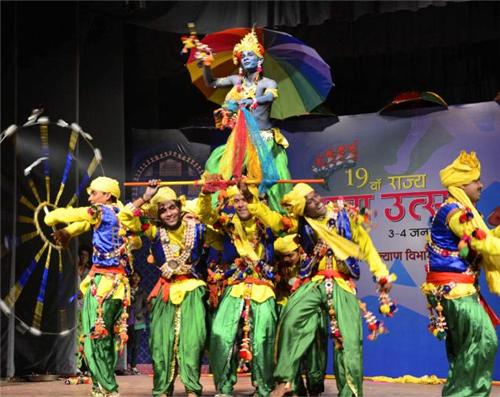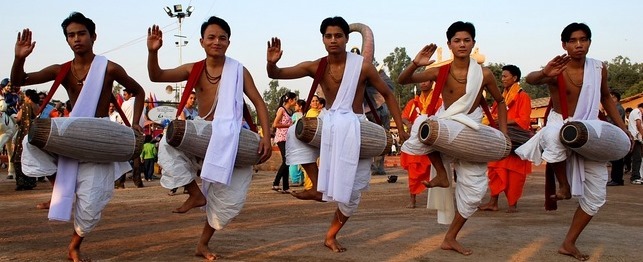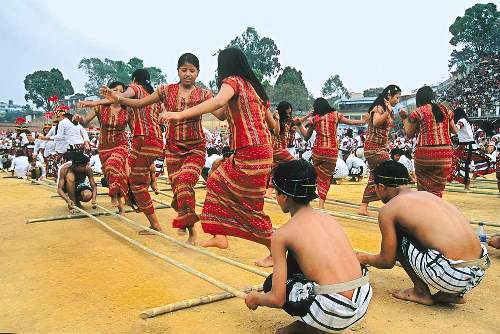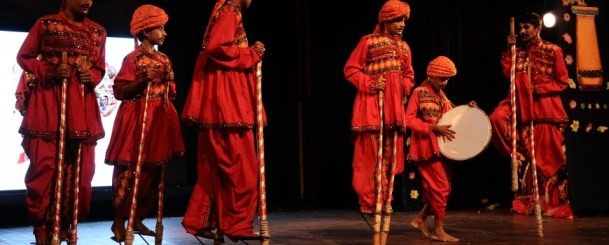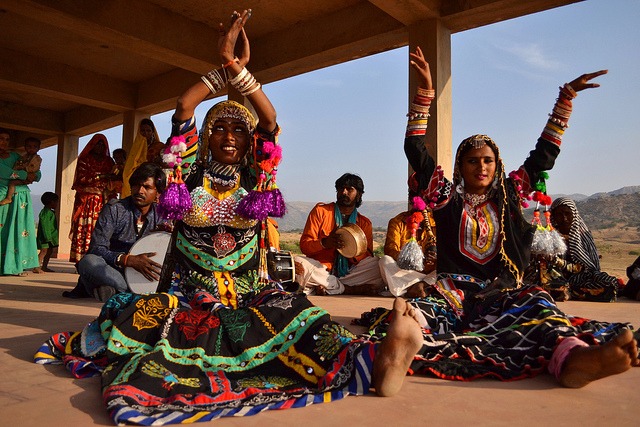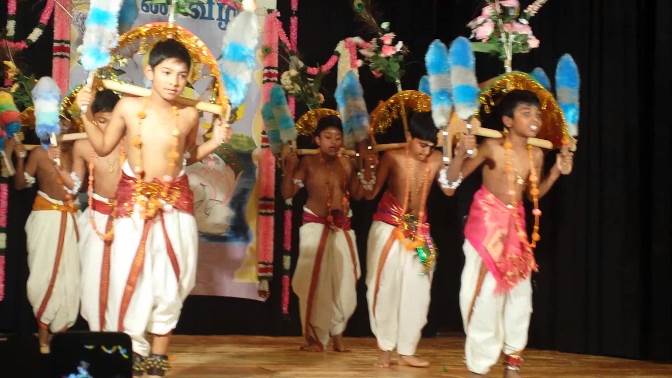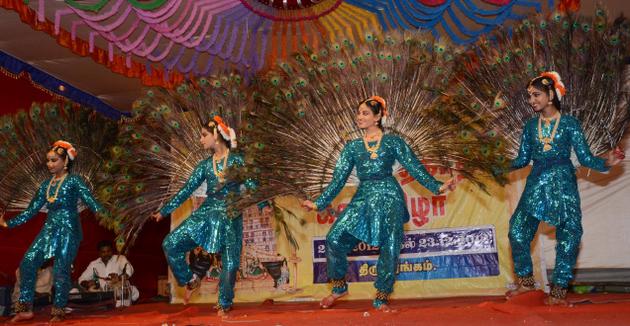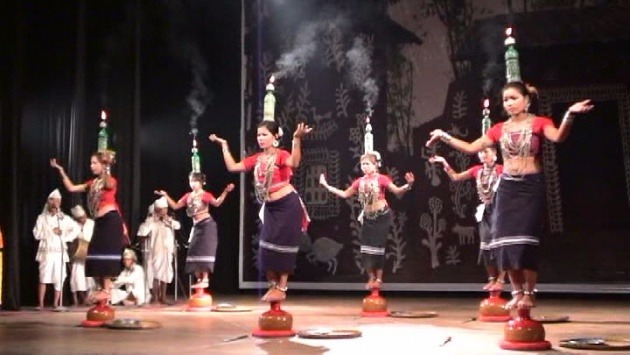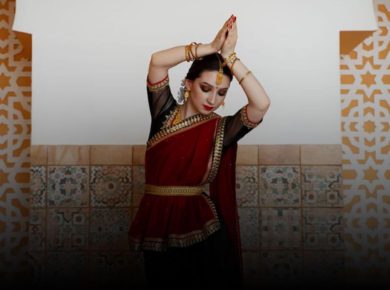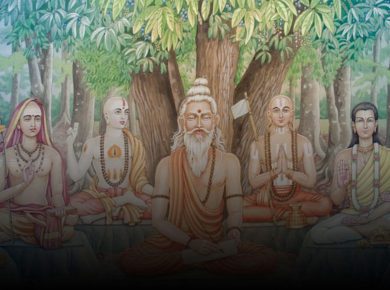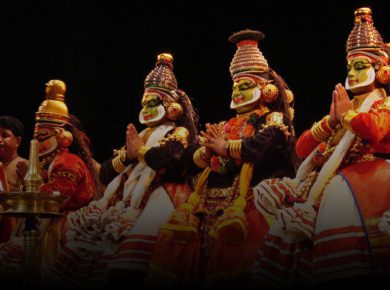Folk Dances of India
Performed for any societal celebrations in villages, for any harvests of food or any celebrations. No particular complex steps to dance. A person without any particular knowledge on dance can also perform it
Mathuri (Koppu) – Andhra Pradesh
- Performed by the inhabitants of the Umji and Indravelli forest areas
- Traditionally performed during Krishna Janmashtami celebrations
- Themes are mainly taken from the Mahabharata
- Though both men and women perform this dance, the pace is different
- Women dance in slow rhythmic movements, while the men dance at a more vigorous pace
- The Nagara is the main instrument used
Bihu (Assam)
- One of the most colourful folk dances of India
- An integral part of the Bihu Festival celebrated to mark the advent of Spring & Assamese New Year
- Bihu ushers in sowing time which is also the season of marriages
Garba (Gujarat)
- The word “Garbo” has originated from Sanskrit word “Garbhdeep”, means an earthen pot with circular holes
- The pot is the symbol of the body and the lighting lamp inside the pot signifies the divine soul
- Linked with the worship of “Shakti” – performed during Navratri & during weddings
- Either a lamp (Garba Deep) or an image of Goddess Durga is placed in middle of concentric rings
- People dance around the centre clapping their hands to the beats of the Dhol
Dandiya Ras (Gujarat)
- Its origin has been traced to Lord Krishna, dancing with Gopis in Vrindavan
- Prominent feature [arr] Circular movements with speed and grace, roar of the Dhol, & the colourful gorgeous costumes
- Depict scenes of Holi and leela of Krishna & Radha, during Navaratras
Daang (Gujarat)
- Hail from South Gujarat on the border of Maharashtra
- Usually performed during Holi and other festivals
- Centers around the social life, feasts, fairs, festivals, ceremonies and rituals connected to worship
- It is vigorous, as most tribal dances are, and highly rhythmic
- Interesting circular formation is created centering around the accompanists who stand in the middle of an open space
- The men hold their arms round the women’s shoulders and women clasp the men by their waists. The dance builds up gradually and acquires a fast tempo in the end
- The women climb on the shoulders of men and form a human pyramid
Siddhi Dhamal (Gujarat)
- The Siddhies migrated to India from Africa about 750 years ago.
- They settled in the coastal parts of Gujarat like Bharuch, Bhavnagar, Junagarh and Surat.
- They follow Muslim religion and dance to the beat of drum on the eve of the Urs of their Prophet Baba Gaur
- Just like their ancestors from Africa, Siddhies are master of rhythm dancing to the tune of huge drums
Jhijhia (Bihar)
- Usually performed by a group of young women dancers
- Portrays offering of prayers to Lord Indra for a good monsoon & a rich harvest
Gaur Maria (Chhattisgarh)
- Basically performed on the occasion of marriage
- Resembles a hunt-dance [arr] imitation of the frisking & jerking movements of the animals
- However, a sense of ritual and deep sanctity underlies the perfect synchronization of the dance.
Kaksar (Chhattisgarh)
- To seek the blessings of the village deity Kaksar for a good harvest
- Performed by a group of young boys and girls dressed in their best
- Provides a platform to young people for choosing their life partners
Chholiya (Uttarakhand)
- Has elements of martial craft and is associated with the Kirji Kumbh celebrations
- Kirji Kumbh is a poisonous flower which blossoms every 12 years
- Villagers march in a procession to destroy the flower before it sheds its poison into the mountain streams
Samay or lamp dance (Goa)
- Performed with traditional metallic lamps or deepaks
- The men and women balance the samai on their heads and perform various movements
- During religious gatherings the dance is performed to the accompaniment of slow singing
Ghoomar (Rajasthan – Haryana)
- Performed by girls of border areas of Rajasthan & Haryana at various festivals like Holi, Gangaur Puja and Teej
- The girls form semi-circles and start singing and clapping
- The dancers then form a circle and the tempo of the dance is accelerated
- The movements are made by holding body weight on one foot and moving forward
- As the tempo increases towards the end, the dancers whirl around in pairs
- Accompanying songs are full of satire and humour and refer to contemporary events
Kinnauri Natti (Himachal Pradesh)
- Important amongst the dances of the Kinauris is Losar Shona Chuksam
- It takes its name from LOSAI meaning new year
- Kinnauries music echoes the sound of the breeze blowing through forests
- Dancers recreate movements of all the agricultural operations of sowing & reaping ogla (barley) and phaphar (a local grain)
- Slow movements with soft knee dips with accentuation of torso are the key step of this dance.
Paika (Jharkhand)
- Typical dance of the Munda community, representing rituals connected with preparations for war
- With chest blades, multi-colored headgear, anklets, bows, arrows, spears, swords & shields the dancers enact battle scenes
- Symbolizes the great war of the Mundas against the Britishers
- Though performed on various occasions, the Paika dance is most readily associated with the Dussehra celebrations
- The fast beat of the madal along with dhol, nagara, shehnai, & ranbheri make Paika dance performaces truly captivating
Rouff (Jammu & Kashmir)
- Most popular dance in the Kashmir Valley and is performed by the women folk
- Performed during harvesting season but the most important occasion is the month of Ramzan
- The girls wear colourful Phirans-Kashmir cloaks and Kasaba-the head gear
- The girls form two rows facing each other and putting their arms around the waist of the next dancer
- They start with rhythmic movements of the feet and weave a few patterns swaying and swinging backward
- Traditionally, no musical accompanies Rouff songs as they are sung while doing the daily chores
- The folk instruments like noot, tumbaknari, rabab etc. are used when it is performed on the stage or in some gathering
Jabro / Losor (Jammu & Kashmir)
- A community dance of the nomadic people of Tibetan origin living in Ladakh
- Jabro is performed by both men & women during Losar- the Tibetan new year celebrations- and also on other festive occasions
- Because of the extreme cold, the dancers wear heavy gowns made of sheep skin, lamb skin caps and long leather shoes
- Performers stand in two facing rows, holding each other’s hands, and dance gracefully with slow, gentle movements
- Jabro songs are sung to the accompaniment of the Damien-a stringed guitar-like instrument and flute
Veerbhadra (Karnataka)
- Veerbhadra is performed on Chaitra Purnima and Dhalo festival
- The person enacting the role of Veerbhadra is dressed in a warriors costume & wield swords as he dances
- According to legend, Veerbhadra is supposed to get possessed by a divine spirit
- The invocation of Veerbhadra is recited in Kannada even today
Dholu Kunitha (Karnataka)
- A drum dance performed by the men folk of the shepherd community known as Kurubas
- Noted for its powerful drumming & vigorous dancing which is filled with acrobatic elements
Oppana (Kerala)
- A bridal dance performed by Muslim girls of North Kerala and Lakshadweep on wedding occasions
- Brides and grooms are mentally prepared for marriage & nuptial night by their close friend through a sequence of dance and music
Purulia Chhau (Orissa, Jharkhand, WB)
- Emanating from martial practice Chhau dance of Purulia draws its themes from the two great Indian epics, Ramayana and Mahabharata
- Masks and elaborate head gears are the ornamental apparels of the Chhau dancers
- Commences with an invocation of Lord Ganesha before movements begin as per the story
- Vocal music replaced by Instrumental music and a variety of drums
- In Chhau dance, the fight between good and evil always culminates in the triumph of good over destructive evil
Badhai (Madhya Pradesh)
- Badhai is performed to thank Goddess Sheetala for safeguarding people from natural calamities & ailments and to seek her blessings on happy occasions like weddings & childbirth
- Accompanied by folk musical instruments, the performers dance gracefully to a rhythm, creating a lively and a colourful spectacle.
- Animals also take part in Badhai Nritya and in many villages, mares (female horses) are seen at such performances.
Baredi (Madhya Pradesh)
- Closely related to the cattle-farm culture of the country, especially of the Bundelkhand region
- Baredi folk songs and folk dances are presented during the fortnight commencing from Deepawali (Kartik Amawasya) to Kartik Poornima
- One of the performers sings two lines from the poem called Baredi with a rhythm & the other participants present a vigorous performance, the Baredi dance
- This dance is presented with a worship of Govardhan Parvat. It is believed that the Lord Krishna himself participate in these Baredi dances alongwith his gwal mates
Raee (Madhya Pradesh)
- Raee folk dance is Popular in Bundelkhand regions of Madhya Pradesh and Uttar Pradesh
- Originated during ancient times for celebrations when the armed forces returned victorious after war
- It is primarily, a female dance, where the dancers with veils on their faces, move their feet and whirl their body in rhythm to the accompanied music
- Algoza, mridanga and dhapali are the main musical instruments used in this dance.
Lavani (Maharashtra)
- Traditionally an integral part of the Tamasha folk theatre of Maharashtra, Lavani is the most popular and best-known folk-dance form of the state
- This art form is at its best when dealing with themes of bravery, pathos, love and devotion, Music, poetry, dance and drama intermingled with perfection
Dhol or Pung Cholom (Manipur)
- Performed usually on religious occasions to the accompaniment of songs and dhol (large drum)
- Usually performed during the Yaoshand festival (or the festival of colours)
- Expresses love and creativity, with an intricate interplay of dhols and fireplay
- Dhol Cholom belongs to the Manipur Sankirtana traditions
Lezim (Maharashtra)
- Have base in a Akhada (Martial Art) tradition of Maharashtra – performed by the artists on religious and social events
- Lezim Dance includes Ghuti Lezim, Ghoongroo Lezim, Dakhani Lezim and Palita Lezim
- This dance is occasionally performed in Madhya Pradesh and Gujarat also
Lewatana (Meghalaya)
- Lewatana is a folk song and dance of Hajong tribe of Meghalaya
- Lewatana is usually performed by the Hajong during the Diwali festival
- Young men and women form a group and while dancing & singing various folk songs, they compare man with nature
Cheraw or Bamboo (Mizoram)
- Also known as the Bamboo Dance, as bamboo forms an integral part of this folk form
- Two long bamboo staves are kept crosswise and horizontally, parallel to ground
- Male dancers clap the staves, resultantly producing a sharp sound setting the rhythm for the dance
- The female dancers, attired in colourful traditional costumes step in and out between bamboos with precise skills
- In addition to the musical pattern created by the clapping of bamboo staves, drums and gongs are also used for effect
Gotipua (Odissa)
- Young boys dressed up as girls sing devotional love songs of Radha-Krishna and perform Gotipua dance
- The repertoire of the dance includes vandana-prayer to God or Guru
- Gotipuas dancers compose themselves in different acrobatic yogic postures creating the images of Radha-Krishna
- Musical accompaniment is provided by Mardala-a pakhawaj, Gini-small cymbals, Harmonium, Violin and flute
Ranappa Chaddhaiya (Odissa)
- Ranappa is a martial art form of dance where the dancers walk and dance on sticks (Ranappa) with special gestures on rhythms of drums
- Ranappa is popular in the coastal areas of Ganjam district of Odisha – Basically an imitation of mock fight
- Chaddaiya is a part of the famous ‘Danda Nata’ of Odisha – Performed in the month of Chaitra, associated with the worship of Shiva
- Worshipers participate in the dance holding a ‘Danda’ (Pole) and a ‘Pasa’ (Knot) symbolic of a devout Shaivite
- They dance vigorously to the accompaniment of drums and ‘Mohri’ displaying various elements of martial practices
Bhangra (Punjab)
- Most popular folk dance of Punjab, performed by men on festive occasions & to celebrate Baisakhi or the harvest festival
- Featured dress [arr] Bright coloured plumed turbans, traditional tehmats, kurtas and waistcoats
Giddha (Punjab)
- Women dance of Punjab at happy occasions – consists of singing, clapping, enacting the Boli as well as pure dance
- Dancers form a circle and participating in pairs, take turns to come centre stage and perform a Boli
- Towards the end of the Boli they dance vigorously in sheer abandon, while those in the circle sing and clap in unison.
- The refrain is sung 3-4 times, then the performers withdraw to be replaced by another pair and a new Boli
- Giddha is accompanied by a Dholak (drum) or Gharah (earthen pot)
Kalbelia (Rajasthan)
- Performed by the women of the nomadic Kalbelia community whose primary occupation is rearing snakes and trading in snake venom
- On festive occasions, traditional songs are sung to the plaintive notes of the ‘been’; and the dancers dressed in their traditional black swirling skirts, perform this dance
- The dance highlights the unparalleled virtuosity of the dancers often reminiscent of the graceful and supple movements of the snake
Chakri (Rajasthan)
- Chakri dance is performed by the women of the Kanjar community of Rajasthan
- The dancers whirl around in circles in colourful skirts which resembles spinning tops & thus named Chakri
- Usually performed at weddings and on festive occasions, Chakri is accompanied by the rhythm of daph, manjira and nagara
Tamang Selo (Sikkim)
- Folk dance of the Tamang community; also known as Damphu as it is performed to the accompaniment of a native musical instrument called damphu
- Usually performed during Dussehra by both men & women; depicts the colourful lifestyle of the hill people
Kavadi (Tamilnadu)
- This dance was supposed to be performed by a giant named Idumban – with a pole slung across his shoulder
- At the two ends of the pole he was supposed to carry the hills of Murugan, the popular deity of Tamil Nadu
- The carrying of Kavadi by pilgrims is symbolic of Idumban with the hillocks poised on the pole
- Accompanying the music, the devotees proceed to the shrine by singing the song “Kavadi Chindu” with quick and vigorous movements.
- Basically performed by the devotees during the ceremonial worship of Murugan the Tamil God of war.
- The Kavadi is never touched by the dancer while dancing.
Kadagam (Tamilnadu)
- Originated as a ritual dedicated to the worship of Mariamman, the Goddess of rain and health
- The ritual is performed during the month of August when the idol of Mariamman is carried in procession
- A ritual pot filled with water is adorned with beautiful decorations, several feet high, and is carried by the priest
- The colourfully attired performers carry decorated vessels vertically on their heads and dance to the tune of accompanying music
- Kadagam dance is very popular in Tamil Nadu, Puducherry, Karnataka and Andhra Pradesh.
Mayilattam (Tamilnadu)
- Performed in Hindu temples
- Dancers wear peacock dress
- Dances on tall woods attached to performers feet
Hojagiri (Tripura)
- Women folk dance of the Reang community of Tripura performed on Mailuma and Maiktah festivals
- Mailuma signifies the festival of new harvest & and Maiktah, worship of Lakshmi, the goddess of wealth and prosperity
- The Reangs believe that when the goddess is pleased by entertaining with dance and songs, she blesses them with bumper crops
- The theme of this dance is mostly connected with cultivation
- Standing on the pitcher, they move the metal plates in hand; & keep a bottle on the head – atop which is an oil lamp alight
Dhobia (Uttar Pradesh)
- Popular among the dhobi (washermen) community of eastern Uttar Pradesh in which only male dancers participate
- Performed on the occasion of birth, marriages and festivals like Dusshehra and Holi
- The dance is basically in the form of a dance-drama which usually begins with the recital of a couplet in praise of the almighty
- Amongst the dancers, one person wearing a royal costume enters the arena riding a dummy horse followed by other dancers
- The group of musicians also stand behind the dancers playing their instruments
- The dance begins with the music provided by drums, cymbals and ghunghroos which are tied on waist and ankles
- A traditional wind instrument, called ransingha, plays a significant role in boosting up the tempo of the dancers
- The dance is accompanied by Bhojpuri and Awadhi folk songs
Some other folk dances of India
| Folk Dance | Place |
| Mask | Ladakh |
| Dhumal | Kashmir |
| Jhoomar | Punjab (Slower and more rhythmic form of Bhangra) |
| Pandavanis | Chhattisgarh, Madhya Pradesh, Orissa, Aandhra Pradesh |
| Changu | Orissa (women, in a half sitting position dance on drum (Changu) beatsDerived its name from a kind of drum called Changu, which invariably accompanies the dance |
| Koli | Fisherman dance of Maharasthra |
| Pongal | Tamilnadu |
| Kummi | Tamilnadu (Performed by Women) |
| Bhutia/Lepcha | Sikkim |
| Wangla | Meghalaya |
Martial Dances of India
| Martial Dances | Place |
| Gatka | Punjab |
| Cholia | Uttarakhand |
| Paika | Odisha |
| Kalaripayattu | Kerala |
| Pang Lhabosol | Sikkim |
| Thang – taa | Manipur |
| Lazim | MH |
